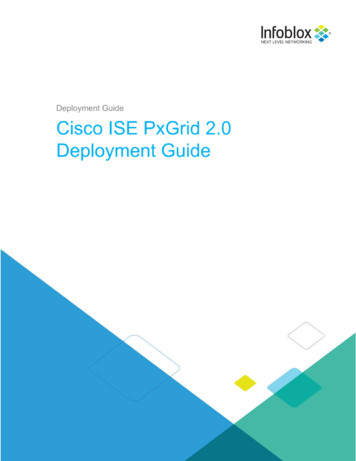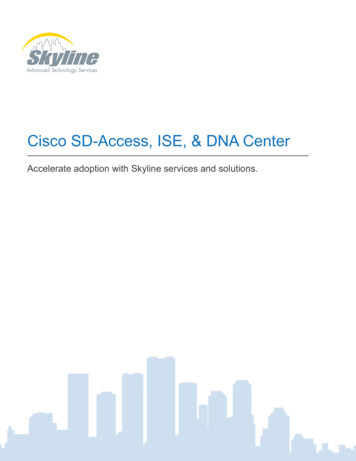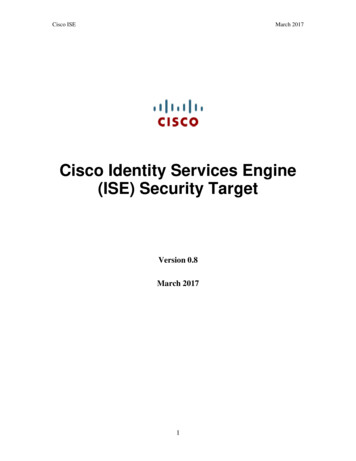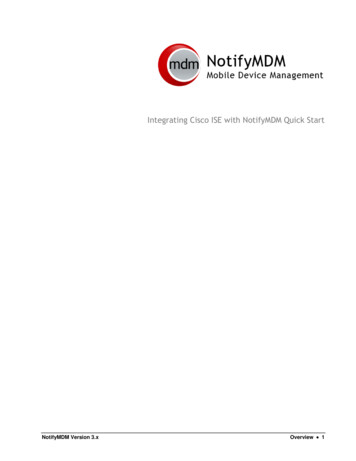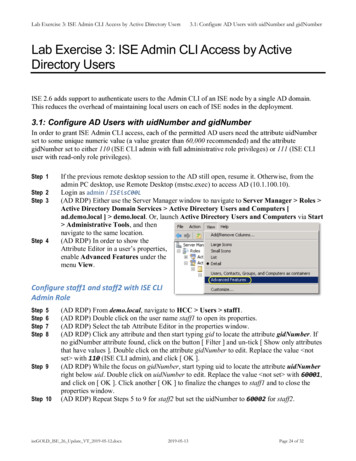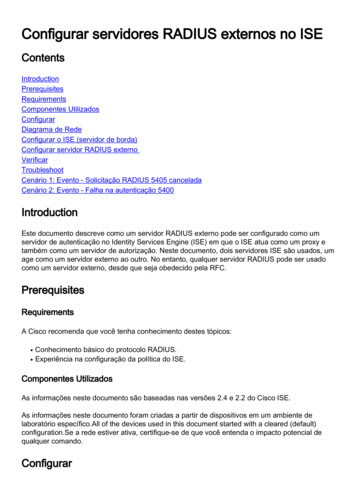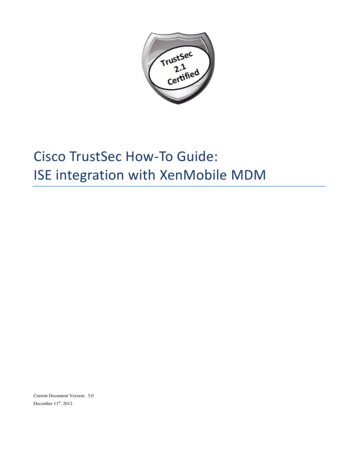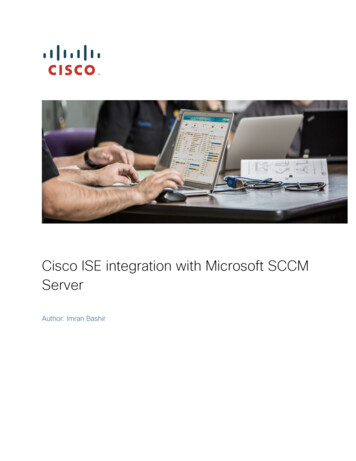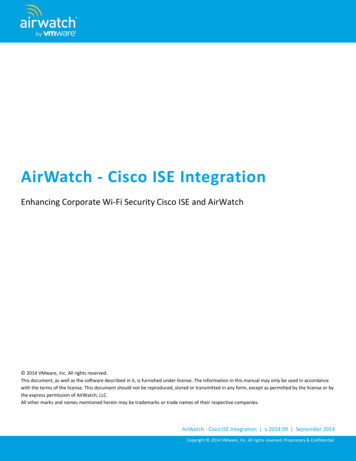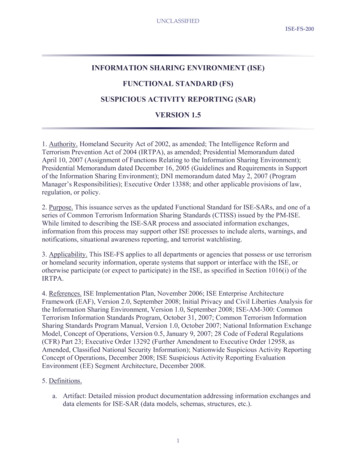
Transcription
UNCLASSIFIEDISE-FS-200INFORMATION SHARING ENVIRONMENT (ISE)FUNCTIONAL STANDARD (FS)SUSPICIOUS ACTIVITY REPORTING (SAR)VERSION 1.51. Authority. Homeland Security Act of 2002, as amended; The Intelligence Reform andTerrorism Prevention Act of 2004 (IRTPA), as amended; Presidential Memorandum datedApril 10, 2007 (Assignment of Functions Relating to the Information Sharing Environment);Presidential Memorandum dated December 16, 2005 (Guidelines and Requirements in Supportof the Information Sharing Environment); DNI memorandum dated May 2, 2007 (ProgramManager’s Responsibilities); Executive Order 13388; and other applicable provisions of law,regulation, or policy.2. Purpose. This issuance serves as the updated Functional Standard for ISE-SARs, and one of aseries of Common Terrorism Information Sharing Standards (CTISS) issued by the PM-ISE.While limited to describing the ISE-SAR process and associated information exchanges,information from this process may support other ISE processes to include alerts, warnings, andnotifications, situational awareness reporting, and terrorist watchlisting.3. Applicability. This ISE-FS applies to all departments or agencies that possess or use terrorismor homeland security information, operate systems that support or interface with the ISE, orotherwise participate (or expect to participate) in the ISE, as specified in Section 1016(i) of theIRTPA.4. References. ISE Implementation Plan, November 2006; ISE Enterprise ArchitectureFramework (EAF), Version 2.0, September 2008; Initial Privacy and Civil Liberties Analysis forthe Information Sharing Environment, Version 1.0, September 2008; ISE-AM-300: CommonTerrorism Information Standards Program, October 31, 2007; Common Terrorism InformationSharing Standards Program Manual, Version 1.0, October 2007; National Information ExchangeModel, Concept of Operations, Version 0.5, January 9, 2007; 28 Code of Federal Regulations(CFR) Part 23; Executive Order 13292 (Further Amendment to Executive Order 12958, asAmended, Classified National Security Information); Nationwide Suspicious Activity ReportingConcept of Operations, December 2008; ISE Suspicious Activity Reporting EvaluationEnvironment (EE) Segment Architecture, December 2008.5. Definitions.a. Artifact: Detailed mission product documentation addressing information exchanges anddata elements for ISE-SAR (data models, schemas, structures, etc.).1
UNCLASSIFIEDISE-FS-200b. CTISS: Business process-driven, performance-based “common standards” for preparingterrorism information for maximum distribution and access, to enable the acquisition,access, retention, production, use, management, and sharing of terrorism informationwithin the ISE. CTISS, such as this ISE-SAR Functional Standard, are implemented inISE participant infrastructures that include ISE Shared Spaces as described in the ISEEAF. Two categories of common standards are formally identified under CTISS:(1) Functional Standards – set forth rules, conditions, guidelines, and characteristics ofdata and mission products supporting ISE business process areas.(2) Technical Standards – document specific technical methodologies and practices todesign and implement information sharing capability into ISE systems.c. Information Exchange: The transfer of information from one organization to anotherorganization, in accordance with CTISS defined processes.d. ISE-Suspicious Activity Report (ISE-SAR): An ISE-SAR is a SAR (as defined below in5i) that has been determined, pursuant to a two-part process, to have a potential terrorismnexus (i.e., to be reasonably indicative of criminal activity associated with terrorism).ISE-SAR business, privacy, and civil liberties rules will serve as a unified process tosupport the reporting, tracking, processing, storage, and retrieval of terrorism-relatedsuspicious activity reports across the ISE.e. National Information Exchange Model (NIEM): A joint technical and functionalstandards program initiated by the Department of Homeland Security (DHS) and theDepartment of Justice (DOJ) that supports national-level interoperable informationsharing.f. Personal Information: Information that may be used to identify an individual (i.e., dataelements in the identified “privacy fields” of this ISE-SAR Functional Standard).g. Privacy Field: A data element that may be used to identify an individual and, therefore,may be subject to privacy protection.h. Suspicious Activity: Observed behavior reasonably indicative of pre-operational planningrelated to terrorism or other criminal activity.i. Suspicious Activity Report (SAR): Official documentation of observed behaviorreasonably indicative of pre-operational planning related to terrorism or other criminalactivity.j. Universal Core (UCore): An interagency information exchange specification andimplementation profile. It provides a framework for sharing the most commonly useddata concepts of “who, what when, and where”. UCore serves as a starting point for datalevel integration and permits the development of richer domain specific exchanges.UCore was developed in concert with NIEM program office, and is a collaborative effortbetween Department of Defense (DOD), DOJ, DHS and the Intelligence Community.2
UNCLASSIFIEDISE-FS-2006. Guidance. This Functional Standard is hereby established as the nationwide ISE FunctionalStandard for ISE-SARs. It is based on documented information exchanges and businessrequirements, and describes the structure, content, and products associated with processing,integrating, and retrieving ISE-SARs by ISE participants.7. Responsibilities.a. The PM-ISE, in consultation with the Information Sharing Council (ISC), will:(1) Maintain and administer this ISE-SAR Functional Standard, to include:(a) Updating the business process and information flows for ISE-SAR.(b) Updating data elements and product definitions for ISE-SAR.(2) Publish and maintain configuration management of this ISE-SAR FunctionalStandard.(3) Assist with the development of ISE-SAR implementation guidance and governancestructure, as appropriate, to address privacy, civil rights, and civil liberties, policy,architecture, and legal issues.(4) Work with ISE participants, through the CTISS Committee, to develop a new ormodified ISE-SAR Functional Standard, as needed.(5) Coordinate, publish, and monitor implementation and use of this ISE-SAR FunctionalStandard, and coordinate with the White House Office of Science and TechnologyPolicy and with the National Institute of Standards and Technology (in theDepartment of Commerce) for broader publication, as appropriate.b. Each ISC member and other affected organizations shall:(1) Propose modifications to the PM-ISE for this Functional Standard, as appropriate.(2) As appropriate, incorporate this ISE-SAR Functional Standard, and any subsequentimplementation guidance, into budget activities associated with relevant current(operational) mission specific programs, systems, or initiatives (e.g. operations andmaintenance {O&M} or enhancements).(3) As appropriate, incorporate this ISE-SAR Functional Standard, and any subsequentimplementation guidance, into budget activities associated with future or newdevelopment efforts for relevant mission specific programs, systems, or initiatives(e.g. development, modernization, or enhancement {DME}).(4) Ensure incorporation of this ISE-SAR Functional Standard, as set forth in 7.b (2) or7.b (3) above, is done in compliance with ISE Privacy Guidelines and any additionalguidance provided by the ISE Privacy Guidelines Committee.3
UNCLASSIFIEDISE-FS-2008. Effective Date and Expiration. This ISE-FS is effective immediately and will remain in effectas the updated ISE-SAR Functional Standard until further updated, superseded, or cancelled.Program Manager for theInformation Sharing EnvironmentDate: May 21, 20094
UNCLASSIFIEDISE-FS-200PART A – ISE-SAR FUNCTIONAL STANDARD ELEMENTSSECTION I – DOCUMENT OVERVIEWA. List of ISE-SAR Functional Standard Technical ArtifactsThe full ISE-SAR information exchange contains five types of supporting technical artifacts.This documentation provides details of implementation processes and other relevant referencematerials. A synopsis of the ISE-SAR Functional Standard technical artifacts is contained inTable 1 below.Table 1 – Functional Standard Technical Artifacts 1Artifact TypeDevelopment andImplementation Tools1ArtifactArtifact Description1. Component MappingTemplate (CMT)(SAR-to-NIEM/UCore)This spreadsheet captures the ISE-SAR informationexchange class and data element (source) definitionsand relates each data element to correspondingNational Information Exchange Model (NIEM)Extensible Mark-Up Language (XML) elements andUCore elements, as appropriate.2. NIEM WantlistThe Wantlist is an XML file that lists the elementsselected from the NIEM data model for inclusion in theSchema Subset. The Schema Subset is a compliantversion to both programs that has been reduced to onlythose elements actually used in the ISE-SAR documentschema.3. XML SchemasThe XML Schema provides a technical representationof the business data requirements. They are a machinereadable definition of the structure of an ISE-SARbased XML Message.4. XML Sample InstanceThe XML Sample Instance is a sample document thathas been formatted to comply with the structuresdefined in the XML Schema. It provides the developerwith an example of how the ISE-SAR schema isintended to be used.5. Codified Data Field ValuesListings, descriptions, and sources as prescribed bydata fields in the ISE-SAR Functional Standard.Development and implementation tools may be accessible through www.ise.gov. Additionally, updated versions of thisFunctional Standard will incorporate the CTISS Universal Core which harmonizes the NIEM Universal Core with the DoD/ICUCore.5
UNCLASSIFIEDISE-FS-200SECTION II – SUSPICIOUS ACTIVITY REPORTING EXCHANGESA. ISE-SAR PurposeThis ISE-SAR Functional Standard is designed to support the sharing, throughout theInformation Sharing Environment (ISE), of information about suspicious activity, incidents, orbehavior (hereafter collectively referred to as suspicious activity or activities) that have apotential terrorism nexus. The ISE includes State and major urban area fusion centers and theirlaw enforcement, 2 homeland security, 3 or other information sharing partners at the Federal, State,local, and tribal levels to the full extent permitted by law. In addition to providing specificindications about possible terrorism-related crimes, ISE-SARs can be used to look for patternsand trends by analyzing information at a broader level than would typically be recognized withina single jurisdiction, State, or territory. Standardized and consistent sharing of suspicious activityinformation regarding criminal activity among State and major urban area fusion centers andFederal agencies is vital to assessing, deterring, preventing, or prosecuting those involved incriminal activities associated with terrorism. This ISE-SAR Functional Standard has beendesigned to incorporate key elements that describe potential criminal activity associated withterrorism and may be used by other communities to address other types of criminal activitieswhere appropriate.B. ISE-SAR ScopeSuspicious activity is defined as observed behavior reasonably indicative of pre-operationalplanning related to terrorism or other criminal activity. A determination that such suspiciousactivity constitutes an ISE-SAR is made as part of a two-part process by trained analysts usingexplicit criteria. Some examples of the criteria for identifying those SARs, with definedrelationships to criminal activity that also have a potential terrorism nexus, are listed below. PartB (ISE-SAR Criteria Guidance) provides a more thorough explanation of ISE-SAR criteria,highlighting the importance of context in interpreting such behaviors; Expressed or implied threat Theft/loss/diversion Site breach or physical intrusion Cyber attacks Probing of security response23All references to Federal, State, local and tribal law enforcement are intended to encompass civilian law enforcement, militarypolice, and other security professionals.All references to homeland security are intended to encompass public safety, emergency management, and other officials whoroutinely participate in the State or major urban area’s homeland security preparedness activities.6
UNCLASSIFIEDISE-FS-200It is important to stress that this behavior-focused approach to identifying suspicious activityrequires that factors such as race, ethnicity, national origin, or religious affiliation should not beconsidered as factors that create suspicion (except if used as part of a specific suspectdescription). It is also important to recognize that many terrorism activities are now being fundedvia local or regional criminal organizations whose direct association with terrorism may betenuous. This places law enforcement and homeland security professionals in the unique, yetdemanding, position of identifying suspicious activities or materials as a byproduct or secondaryelement in a criminal enforcement or investigation activity. This means that, while some ISESARs may document activities or incidents to which local agencies have already responded,there is value in sharing them more broadly to facilitate aggregate trending or analysis.Suspicious Activity Reports are not intended to be used to track or record ongoing enforcement,intelligence, or investigatory operations although they can provide information to these activities.The ISE-SAR effort offers a standardized means for sharing information regarding behaviorpotentially related to terrorism-related criminal activity and applying data analysis tools to theinformation. Any patterns identified during ISE-SAR data analysis may be investigated incooperation with the reporting agency, Joint Terrorism Task Force (JTTF), or the State or majorurban area fusion center in accordance with departmental policies and procedures. Moreover, thesame constitutional standards that apply when conducting ordinary criminal investigations alsoapply to local law enforcement and homeland security officers conducting SAR inquiries. Thismeans, for example, that constitutional protections and agency policies and procedures that applyto a law enforcement officer’s authority to stop, stop and frisk (“Terry Stop”) 4 , requestidentification, or detain and question an individual would apply in the same measure whether ornot the observed behavior related to terrorism or any other criminal activity.C. Overview of Nationwide SAR CycleAs defined in the Nationwide Suspicious Activity Reporting Initiative (NSI) Concept ofOperations (CONOPS 5 ) and shown in Figure 1, the nationwide SAR process involves a total of12 discrete steps that are grouped under five standardized business process activities – Planning,Gathering and Processing, Analysis and Production, Dissemination, and Reevaluation. The toplevel ISE-SAR business process described in this section has been revised to be consistent withthe description in the NSI CONOPS. Consequently, the numbered steps in Figure 1 are the onlyones that map directly to the nine-steps of the detailed information flow for nationwide SARinformation sharing documented in Part C of this version of the ISE-SAR Functional Standard.For further detail on the 12 NSI steps, please refer to the NSI CONOPS.45“Terry Stop” refers to law enforcement circumstances related to Supreme Court of the United States ruling on “Terry v. Ohio(No. 67)” argued on December 12, 1967 and decided on June 10, 1968. This case allows a law enforcement officer toarticulate reasonable suspicion as a result of a totality of circumstances (to include training and experience) and take action tofrisk an individual for weapons that may endanger the officer. The Opinion of the Supreme Court regarding this case may befound at Internet site SC CR 0392 0001 ZO.html.PM-ISE, Nationwide SAR Initiative Concept of Operations (Washington: PM-ISE, 2008), available from www.ise.gov.7
UNCLASSIFIEDISE-FS-200Federal agenciesproduce and makeavailable informationproducts to supportthe development ofgeographic riskassessments by stateand major urban areafusion centersNationalcoordinatedinformationneeds onannual andad hoc basis78State and majorurban areafusion centers,in coordinationwith local-Feds,develop riskassessmentsState and majorurban area fusioncenters, incoordination withlocal-Feds, developinformation needsbased on riskassessmentFront line LEpersonnel (FSLT)trained to recognizebehavior andincidents indicative ofcriminal activityassociated withterrorism; Communityoutreach planimplemented9Observation andreporting ofbehaviors andincidents by trainedLE personnel during Supervisory reviewtheir routine activity of the report inaccordance withdepartmental policy12Nationwide SAR Cycle65Authorized ISEparticipantsaccess andretrieve ISE-SARISE-SARposted in anISE SharedSpace34Determination anddocumentation ofan ISE-SARAt fusion center or JTTF,a trained analyst or LE officerdetermines, based oninformation available,knowledge, experience, andpersonal judgment, whetherthe information meeting theISE-SAR criteria may have aterrorism nexusSAR madeavailable tofusion centerand/or JTTFIn major cities,SAR reviewed bytrained CT expertSuspicious Activity Processing StepsPlanningGathering and ProcessingAnalysis and ProductionDisseminationReevaluationFigure 1. Overview of Nationwide SAR ProcessD. ISE-SAR Top-Level Business Process1. PlanningThe activities in the planning phase of the NSI cycle, while integral to the overall NSI, arenot discussed further in this Functional Standard. See the NSI CONOPS for more details. 62. Gathering and ProcessingLocal law enforcement agencies or field elements of Federal agencies gather and documentsuspicious activity information in support of their responsibilities to investigate potentialcriminal activity, protect citizens, apprehend and prosecute criminals, and prevent crime.Information acquisition begins with an observation or report of unusual or suspiciousbehavior that may be indicative of criminal activity associated with terrorism. Such activitiesinclude, but are not limited to, theft, loss, or diversion, site breach or physical intrusion,cyber attacks, possible testing of physical response, or other unusual behavior or sectorspecific incidents. It is important to emphasize that context is an essential element ofinterpreting the relevance of such behaviors to criminal activity associated with terrorism.(See Part B for more details.)6Ibid., 17-18.8
UNCLASSIFIEDISE-FS-200Regardless of whether the initial observer is a private citizen, a representative of a privatesector partner, a government official, or a law enforcement officer, suspicious activity iseventually reported to either a local law enforcement agency or a local, regional, or nationaloffice of a Federal agency. When the initial investigation or fact gathering is completed, theinvestigating official documents the event in accordance with agency policy, localordinances, and State and Federal laws and regulations.The information is reviewed within a local or Federal agency by appropriately designatedofficials for linkages to other suspicious or criminal activity in accordance with departmentalpolicy and procedures. 7 Although there is always some level of local review, the degreevaries from agency to agency. Smaller agencies may forward most SARs directly to the Stateor major urban area fusion center or JTTF with minimal local processing. Major cities, on theother hand, may have trained counterterrorism experts on staff that apply a more rigorousanalytic review of the initial reports and filter out those that can be determined not to have apotential terrorism nexus.After appropriate local processing, agencies make SARs available to the relevant State ormajor urban area fusion center. Field components of Federal agencies forward their reports tothe appropriate regional, district, or headquarters office employing processes that vary fromagency to agency. Depending on the nature of the activity, the information could cross thethreshold of “suspicious” and move immediately into law enforcement operations channelsfor follow-on action against the identified terrorist activity. In those cases where the localagency can determine that an activity has a direct connection to criminal activity associatedwith terrorism, it will provide the information directly to the responsible JTTF for use as thebasis for an assessment or investigation of a terrorism-related crime as appropriate.3. Analysis and ProductionThe fusion center or Federal agency enters the SAR into its local information system andthen performs an additional analytic review to establish or discount a potential terrorismnexus. First, an analyst or law enforcement officer reviews the newly reported informationagainst ISE-SAR criteria outlined in Part B of this ISE-SAR Functional Standard. Second,the Terrorist Screening Center (TSC) should be contacted to determine if there is valuableinformation in the Terrorist Screening Database. Third, he or she will review the inputagainst all available knowledge and information for linkages to other suspicious or criminalactivity.Based on this review, the officer or analyst will apply his or her professional judgment todetermine whether the information has a potential nexus to terrorism. If the officer or analystcannot make this explicit determination, the report will not be accessible by the ISE, although7If appropriate, the agency may consult with a Joint Terrorism Task Force, Field Intelligence Group, or fusion center.9
UNCLASSIFIEDISE-FS-200it may be retained in local fusion center or Federal agency files in accordance withestablished retention policies and business rules. 84. DisseminationOnce the determination of a potential terrorism nexus is made, the information becomes anISE-SAR and is formatted in accordance with the ISE-SAR Information Exchange PackageDocument (IEPD) format described in Sections III and IV. This ISE-SAR is then stored inthe fusion center, JTTF, or other Federal agency’s ISE Shared Space 9 where it can beaccessed by authorized law enforcement and homeland security personnel in the State ormajor urban area fusion center’s area of responsibility as well as other ISE participants,including JTTFs. This allows the fusion center to be cognizant of all terrorist-relatedsuspicious activity in its area of responsibility, consistent with the information flowdescription in Part C. Although the information in ISE Shared Spaces is accessible by otherISE participants, it remains under the control of the submitting organization, i.e., the fusioncenter or Federal agency that made the initial determination that the activity constituted anISE-SAR.By this stage of the process, all initially reported SARs have been through multiple levels ofreview by trained personnel and, to the maximum extent possible, those reports without apotential terrorism nexus have been filtered out. Those reports posted in ISE Shared Spaces,therefore, can be presumed by Federal, State, and local analytic personnel to be terrorismrelated and information derived from them can be used along with other sources to supportcounterterrorism operations or develop counterterrorism analytic products. As in any analyticprocess, however, all information is subject to further review and validation, and analystsmust coordinate with the submitting organization to ensure that the information is still validand obtain any available relevant supplementary material before incorporating it into ananalytic product.Once ISE-SARs are accessible, they can be used to support a range of counterterrorismanalytic and operational activities. This step involves the actions necessary to integrate ISESAR information into existing counterterrorism analytic and operational processes, includingefforts to “connect the dots,” identify information gaps, and develop formal analyticproducts. Depending on privacy policy and procedures established for the NSI as a whole orby agencies responsible for individual ISE Shared Spaces, requestors may only be able toview reports in the Summary ISE-SAR Information format, i.e., without privacy fields. Inthese cases, requestors should contact the submitting organization directly to discuss theparticular report more fully and obtain access, where appropriate, to the information in theprivacy fields.8As was already noted in the discussion of processing by local agencies, where the fusion center or Federal agency candetermine that an activity has a direct connection to a possible terrorism-related crime, it will provide the information directly tothe responsible JTTF for use as the basis for an assessment or investigation.9PM-ISE, ISE Enterprise Architecture Framework, Version 2.0, (Washington: PM-ISE, 2008), 61-6310
UNCLASSIFIEDISE-FS-2005. Reevaluation 10Operational feedback on the status of ISE-SARs is an essential element of an effective NSIprocess with important implications for privacy and civil liberties. First of all, it is importantto notify source organizations when information they provide is designated as an ISE-SARby a submitting organization and made available for sharing—a form of positive feedbackthat lets organizations know that their initial suspicions have some validity. Moreover, theprocess must support notification of all ISE participants when further evidence determinesthat an ISE-SAR was designated incorrectly so that the original information does notcontinue to be used as the basis for analysis or action. This type of feedback can supportorganizational redress processes and procedures where appropriate.E. Broader ISE-SAR ApplicabilityConsistent with the ISE Privacy Guidelines and Presidential Guideline 2, and to the full extentpermitted by law, this ISE-SAR Functional Standard is designed to support the sharing ofunclassified information or sensitive but unclassified (SBU)/controlled unclassified information(CUI) within the ISE. There is also a provision for using a data element indicator for designatingclassified national security information as part of the ISE-SAR record, as necessary. Thiscondition could be required under special circumstances for protecting the context of the event,or specifics or organizational associations of affected locations. The State or major urban areafusion center shall act as the key conduit between the State, local, and tribal (SLT) agencies andother ISE participants. It is also important to note that the ISE Shared Spaces implementationconcept is focused exclusively on terrorism-related information. However many SAR originatorsand consumers have responsibilities beyond terrorist activities. Of special note, there is nointention to modify or otherwise affect, through this ISE-SAR Functional Standard, the currentlysupported or mandated direct interactions between State, local, and tribal law enforcement andinvestigatory personnel and the Joint Terrorism Task Forces (JTTFs) or Field IntelligenceGroups (FIGs).This ISE-SAR Functional Standard will be used as the ISE-SAR information exchange standardfor all ISE participants. Although the extensibility of this ISE-SAR Functional Standard doessupport customization for unique communities, jurisdictions planning to modify this ISE-SARFunctional Standard must carefully consider the consequences of customization. The PM-ISErequests that modification follow a formal change request process through the ISE-SAR SteeringCommittee and CTISS Committee under the Information Sharing Council, for both communitycoordination and consideration. Furthermore, messages that do not conform to this FunctionalStandard may not be consumable by the receiving organization and may require modifications bythe nonconforming organizations.10The Reevaluation Phase also encompasses the establishment of an integrated counterterrorism information needs process, aprocess that does not relate directly to information exchanges through this standard. See page 23 of the NSI CONOPS formore details.11
UNCLASSIFIEDISE-FS-200F. Protecting PrivacyLaws that prohibit or otherwise limit the sharing of personal information vary considerablybetween the Federal, State, local, and tribal levels. The Privacy Act of 1974 (5 USC §552a) asamended, other statutes such as the E-Government Act, and many government-wide ordepartmental regulations establish a framework and criteria for protecting information privacy inthe Federal Government. The ISE must facilitate the sharing of information in a lawful manner,which by its nature must recognize, in addition to Federal statutes and regulations, differentState, local or tribal laws, regulations, or policies that affect privacy. One method for protectingprivacy while enabling the broadest possible sharing is to anonymize ISE-SAR reports byexcluding data elements that contain personal information. Accordingly, two different formatsare available for ISE-SAR information. The Detailed ISE-SAR IEPD format includes personalinformation contained in the data fields set forth in Section IV of this ISE-SAR FunctionalStandard (“ISE-SAR Exchange Data Model”), including “privacy fields” denoted as containingpersonal information. If an ISE participant is not authorized to disseminate personal informationfrom an ISE Shared Space (e.g., the requester site does not have a compliant privacy policy) orthe SAR does not evidence the necessary nexus to terrorism-related crime (as required by thisISE-SAR Functional Standard), information from the privacy fields will not be loaded into theresponsive document (search results) from the ISE Shared Space. This personal information willnot be passed to the ISE participant. The Summary ISE-SAR Information format excludesprivacy fields or data elements identified in Section IV of this ISE-SAR Functional Standard ascontaining per
The full ISE-SAR information exchange contains five types of supporting technical artifacts. This documentation provides details of implementation processes and other relevant reference materials. A synopsis of the . ISE-SAR Functional Standard. technical artifacts is contained in Table 1 below. Table 1 - Functional Standard Technical .
